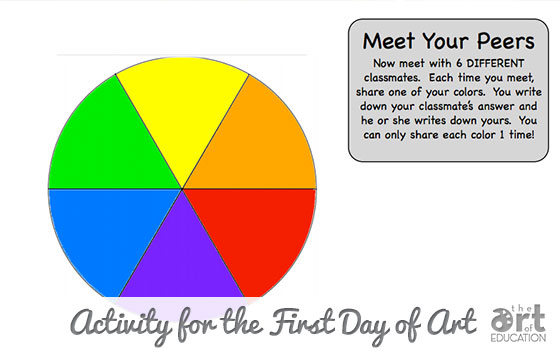
The beginning of the year is full of excitement. There are new school supplies to ogle, rooms that have freshly waxed floors and sparkling tables (maybe for the only time all year), and a clean slate, a fresh start for everyone. For me, the downside to the beginning of the year (aside from saying goodbye to a leisurely summer vacation – sniffle, sniffle), is the repetition of those first few days of class.
At the elementary level, it can take a good week, or longer, before you have greeted every student and reviewed every rule. If you’re like me, by the time Thursday afternoon rolls around your “Welcome Back!” has lost some of its pep and vinegar! So, how do you keep things interesting for students and yourself?
One activity that I have used and found great success with is a color wheel inspired introduction activity.
It begins with a color wheel themed PowerPoint presentation I whipped up to introduce myself to all my students in grades K-5. It’s a quick, engaging way for students to get to know a little more about me, which helps build rapport that lasts throughout the school year. I pair each color of the color wheel with a fun fact about myself. The students love to try and guess what I put for each color!
If you’d like, you can view my PowerPoint by clicking below.

Next, for grades 3 and up, I let students use the color wheel to tell about themselves and their classmates. You can click below to download the PDF that I use for this activity.

Here’s how it works.
1. Students complete the top of the sheet by writing down one word, idea or phrase that tells about them for each color.
For example, a student might write down, “I like swimming in the ocean,” for the color blue or, “I just got new red glasses,” for the color red.
2. To complete the bottom of the sheet, students meet with each other and record each other’s answers.
For example, if I met with a student, the student would record, “Mrs. Crockett likes tomatoes,” in the red portion of the color wheel, and I would record that student’s name and idea for red as well. The goal is for each student to meet with six other students to fill in his or her color wheel completely. I highly recommend modeling this second step so students can see how it works.
3. Students return to their seats for a class discussion.
This is where you can get really creative.
Here are some sample prompts and ideas to try, depending on the amount of time you have to spend on this activity:
- Graph the students’ favorite colors
- Have students meet with certain color partners to answer art questions. For example, “Find your red partner and discuss your favorite artist.”
- Compile a list favorite sports teams mentioned
- Ask students questions like: What is the most unusual thing you learned about a classmate during this activity? Did anyone mention traveling this summer? Who traveled the farthest? Did anyone mention favorite foods?
I collect and read through the color wheel sheets at the end of class. It gives me an opportunity to get to know my students a little bit more and to see their writing. Eventually, these sheets will make their way into student portfolios and we will refer back to them during color theory or when I need to quickly assign random partners.
As an added bonus, this project makes connections to both math (shapes, fractions) and english/language arts (writing, reading). It is just a small sampling of students’ abilities, but this insight is helpful as I continue to collaborate and integrate standards.
Does anyone else use the color wheel for a get-to-know-you activity?
How do you kick off the beginning of the school year? We’d love to know.
Magazine articles and podcasts are opinions of professional education contributors and do not necessarily represent the position of the Art of Education University (AOEU) or its academic offerings. Contributors use terms in the way they are most often talked about in the scope of their educational experiences.




